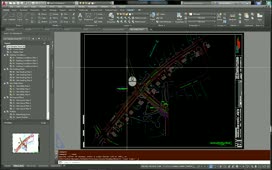The program includes a built-in calculator that you can use to perform calculations at any time, even while in the middle of another command.
To access the calculator, on the Home ribbon, in the Utilities panel, click the Quick Calculator tool. You can also access the calculator by simply right-clicking and choosing QuickCalc from the shortcut menu.
The calculator appears in the form of the QUICKCALC palette, which behaves like any other palette. It can be displayed floating, docked, or anchored to the left or right side of the drawing window. When floating, it can be moved and resized. You can also click the Properties button or right-click the palette title bar and adjust the Auto-hide and Transparency settings.
The QUICKCALC palette includes a number of tools that can be expanded or collapsed. On the Number Pad are tools that enable you to perform basic calculator functions, such as Add, Subtract, Divide, and Multiply. For example, if you multiply 8 times 6 and click the equal ( = ) button, you see the results of the calculation. You can then click the Paste value to command line button to paste the resulting value into the command line as input. Each calculation also appears in the upper portion of the calculator so that they can be reused again later.
Collapse the Number Pad and then expand the Scientific panel. Here, you can find tools to perform calculations involving trig functions, log functions, and exponents.
Collapse that panel and expand Units Conversion. This panel contains tools for converting between different units of measure. For example, with the Units type set to Length, click in the Convert from field, expand the drop-down, and select Inches. Then, click in the Convert to field, expand that drop-down, and select Millimeters. The calculator immediately shows you the converted value based on the most recent calculation. Click in the Converted value field and then click Return Conversion to Calculator Input Area to place that converted value into the calculator. From here, you can easily paste it into the command line as input.
Click in the Units type field and expand the drop-down. You can convert length, area, volume, and angular measurements. Choose Area. Then, in the Convert from drop-down, choose Square yards, and in the Convert to drop-down, choose Acres.
Collapse the Units Conversion panel and expand Variables. Here, you can see some sample variables you can use to perform additional calculations. For example, dee finds the distance between two endpoints. Note that you can also click the New Variable… button to display the Variable Definition dialog so that you can define your own custom variable. Click Cancel.
You can use the Quick Calculator to perform calculations while the program is in the middle of a command. For example, click the Close button to close the Quick Calculator. Suppose you wanted to place a circle in the center of the green rectangle. While you could do this using object snap tracking, you can also accomplish the same thing by using the Quick Calculator.
Zoom in on the rectangle and then start the CIRCLE command. When the program prompts you to specify the center point for the circle, right-click and choose QuickCalc from the shortcut menu. Now the calculator is running inside an active command and you see a QuickCalc dialog box.
In the Variables panel, select the function called mee (which stands for midpoint between two endpoints), and click the Return Variable to Input Area button (or you could simply double-click mee ). The function has been placed in the calculator input area. Click Apply. The Quick Calculator disappears and the program prompts you to Select entity for END snap. Click to select one corner of the rectangle. The prompt then repeats. Click to select the opposite corner of the rectangle. As soon as you do, the program locates the center of the circle and prompts you to specify its radius. Type “10” and press ENTER.
Consider another situation in which you might use the Quick Calculator. Use the LINE command to draw a line segment at a random angle. Suppose you wanted to rotate the green polygon on the left using its lower-left corner as the base point, so that the long edge is aligned at the same angle as the line you just drew. Again, there are several methods you could use to accomplish this, such as using the Reference option of the ROTATE command. But there is an easy way to perform this task using the Quick Calculator.
On the Home ribbon, in the Modify panel, click the Rotate tool. The program prompts you to select objects. Select the six green lines that comprise the polygon, and then right-click to complete the object selection. Next, the program prompts you to specify the base point. Use Endpoint Object Snap to select the lower-left corner. Next, right-click and choose QuickCalc. In the QuickCalc dialog, click Angle of Line Defined by Two Points.
The dialog disappears and the program prompts you to enter a point. Click to select the left end of the angled line. The prompt repeats. Click to select the right end of the angled line. The QuickCalc dialog reappears and the angle of the line now appears in the input area. Click Apply to paste the angle value to the command line. Now, simply press ENTER to complete the command. The polygon is immediately rotated.
Right-click and open the QUICKCALC palette again. All of the values you calculated appear in the upper portion of the palette and can easily be reused again at any time.
Source: Autodesk




